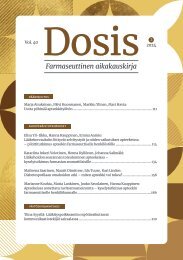DOSIS 1/2021
Farmaseuttinen aikakauskirja DOSIS 1/2021 vol.37 5uomen Farmasialiitto ry
Farmaseuttinen aikakauskirja DOSIS 1/2021 vol.37 5uomen Farmasialiitto ry
Create successful ePaper yourself
Turn your PDF publications into a flip-book with our unique Google optimized e-Paper software.
Summary<br />
Implementing the use of automated<br />
drug dispensing cabinets in intensive<br />
care, high dependency and cardiac<br />
care units – developing medication<br />
processes in collaboration between<br />
hospital pharmacy and nurses<br />
Tarja Mikkola*<br />
BSc (Pharm)<br />
Seinäjoki Central Hospital<br />
tarja.mikkola@epshp.fi<br />
Meri Järvenpää<br />
MSc (Pharm)<br />
Seinäjoki Central Hospital<br />
Kirsi Aronpuro<br />
MSc (Pharm),<br />
specialisation in ward pharmacy<br />
Turku University Central Hospital<br />
Raisa Laaksonen<br />
MSc (Pharm), PhD, Senior Lecturer,<br />
Adjunct Professor in Clinical Pharmacy<br />
Specialisation Programme in Community and<br />
Hospital Pharmacy, Clinical Pharmacy Group,<br />
Faculty of Pharmacy, University of Helsinki<br />
* Correspondence<br />
Introduction<br />
Automated drug dispensing cabinets can be<br />
utilised to improve medication and patient<br />
safety. This study aimed to describe the effects<br />
of the implementation of the use of automated<br />
drug dispensing cabinets on medication processes,<br />
develop the medication processes, to<br />
describe the perceptions and views of nurses<br />
of the medication processes before and after<br />
implementing the use of the automated drug<br />
dispensing cabinets and to describe and solve<br />
any issues occurring in the use of the cabinets.<br />
Materials and methods<br />
A longitudinal before-and-after action<br />
research approach with four phases was utilised.<br />
The study was completed at the intensive<br />
care, high dependency and cardiac care units<br />
of Seinäjoki Central Hospital. Nurses who dispense<br />
and administer medicines were recruited<br />
to participate in group interviews and a survey<br />
during the implementation process of the<br />
automated drug dispensing cabinets. Participation<br />
was voluntary and confidential. Additionally,<br />
notes taken at the project group meetings<br />
were utilised in the content analysis of the data.<br />
Results<br />
The medication processes was standardised<br />
after implementing the use of the automated<br />
drug dispensing cabinets. In the new medication<br />
process, the nurses check the current<br />
details of the prescribed drugs on a patient’s<br />
electronic drug list, and dispensing and/or<br />
preparation of drugs occur immediately before<br />
drug administration. The nurses do not regularly<br />
order drugs from the hospital pharmacy.<br />
Instead, the automated drug dispensing cabinets<br />
check the consumption of drugs and compile<br />
a suggested list of drugs to be ordered. A<br />
ward pharmacist orders the drugs for the cabinets<br />
three times weekly. The hospital pharmacy<br />
owns the drugs in the cabinets and is responsible<br />
for ordering, filling and stocktaking.<br />
The nurses who participated in the study<br />
were mostly satisfied with the use of the automated<br />
drug dispensing cabinets. The nurses<br />
thought that the use of the cabinets had lightened<br />
their workload. They reported that the use<br />
of the cabinets was easy to adopt and that new<br />
employees were quick learners. The reported<br />
issues occurring in the use of the cabinets<br />
were mainly technical problems in the operating<br />
system or other technical problems that<br />
were possible to solve. However, it was not<br />
possible to solve issues that were linked to the<br />
assembly of the cabinets and that affected their<br />
functionality. Implementation of the use of the<br />
automated drug dispensing cabinets requires<br />
detailed planning and sufficient training of<br />
staff.<br />
The longitudinal action research approach,<br />
that is, consultation of staff, made it possible to<br />
the nurses to influence how they use the cabinets<br />
and how drugs were ordered in the cabinets.<br />
To make it easier to collect the drugs for<br />
administration, the drawers were divided into<br />
smaller sections and drugs were grouped based<br />
on ATC codes. Based on the feedback received,<br />
the standard operating procedures for using<br />
the cabinets and the information provided on<br />
the cabinets and their implementation process<br />
were improved. The implementation project<br />
and the research method used in this study<br />
increased the collaboration between the staff<br />
at the three units and the hospital pharmacy.<br />
Conclusions<br />
This study reports how the implementation<br />
of the use of automated drug dispensing cabinets<br />
may influence medication processes. The<br />
systematic collection of data before and after<br />
the implementation enabled development and<br />
standardisation of the medication process. The<br />
new processes were developed together with<br />
the nurses, thus, enabling the user perspective<br />
to be heard. This study assisted in fostering<br />
interprofessional collaboration between<br />
nurses and pharmacists.<br />
Keywords: Automation, automated drug<br />
dispensing cabinet, automated drug<br />
dispensing system, medication process<br />
Sidonnaisuudet<br />
Ei sidonnaisuuksia.<br />
94 Dosis Vol. 37 1/<strong>2021</strong> © Suomen Farmasialiitto ry Suomen Farmasialiitto ry © 1/<strong>2021</strong> Vol. 37 Dosis 95

















